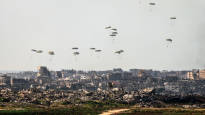The aerial video shows the disproportion between the need for help and the amount. Individual packets fall in the middle of a dense population.
The humanitarian situation in Gaza is deteriorating very rapidly.
About 300,000 people need immediate help.
Among other things The UN warns of famine, unless relief transports can be made to work. A temporary port is to be built in Gaza for the grant.
The United States and several other countries have experimented with airlifts of aid packages. Here are a few reasons why drop aid has not been effective in the Gaza Strip.
Several media outlets write about the topic, including the British broadcasting company BBC.
1. People die under packages
According to eyewitnesses, at least five people died in Gaza after being trapped under an aid box dropped by parachute from an airplane on Friday. Aid was dropped at al-Shari camp. In addition, several people are said to have been injured.
2. Some of the parachutes are defective
In quickly organized relief flights, the equipment is not in order. For example, some of the parachutes have not opened normally.
On Tuesday, the United States and Jordan dropped 36,000 aid packages into Gaza.
3. Packages are robbed and fought over
Aid does not reach the most vulnerable. People rushing after the package argue and some get trampled in the crowd.
In recent weeks, the free bridge has been opened more than 20 times. In addition to the United States and Jordan, Israel, France, the United Arab Emirates and Egypt, among others, have participated in the delivery of aid transported by airplanes.
The packages dropped on Friday contained, among other things, feminine hygiene products and vegetables.
4. Expensive form of assistance
Aid dropped from airplanes was used for the first time in World War II, when packages were delivered to blockaded troops.
The UN introduced air aid in 1973. Aid has been delivered to victims of floods and earthquakes, for example.
However, air deliveries are called the “last chance” due to the uncertainty and cost of deliveries. The World Food Program under the UN, WFP, has used airplanes for the last time in South Sudan.
Air freight is expensive due to aircraft rental, personnel and aircraft fuel.
The Secretary General of Norway’s refugee aid, who recently visited Gaza Jan Egeland criticizes airplane aid deliveries as an “expensive and random form of aid”.
The need for help is dire, but WFP also supports the urgent start of other deliveries.
According to the food program, air transport is seven times more expensive than aid delivered by land. In addition, help is delivered in small amounts at a time.
